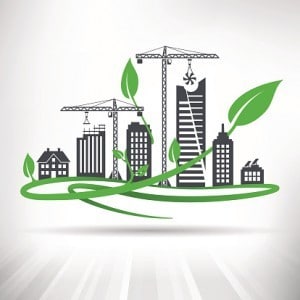Why LEED certification is good for your business
 More and more business leaders are becoming aware of the need to reduce their carbon footprint by incorporating sustainability practices into their businesses. But “going green” doesn’t have to mean making a sacrifice for the greater good. You can save the planet and lower your operations costs in the process. It’s a win-win!
More and more business leaders are becoming aware of the need to reduce their carbon footprint by incorporating sustainability practices into their businesses. But “going green” doesn’t have to mean making a sacrifice for the greater good. You can save the planet and lower your operations costs in the process. It’s a win-win!
One option that enables businesses to make long-term improvements to their facilities’ sustainability is LEED certification. Several types of this certification are available, among them LEED for Existing Buildings: Operation and maintenance (LEED EB: O&M). With the building replacement rate in the U.S. at less than 2%, making existing buildings greener is arguably the most important step we can take toward sustainability. And when working with existing buildings, going green is a process of constant improvement rather than a set of finite tasks.
Companies that enroll in the LEED program can make changes to many aspects of their buildings’ operations, such as retrofitting building systems with energy-efficient technologies and purchasing eco-friendly consumables. And of course, a building’s sustainability efforts must be ongoing — certification doesn’t mean taking a few steps and stopping there.
Earning LEED certification
A building can earn points within specific categories (called credits), such as energy performance, indoor air quality, purchasing, and interior lighting. Those points are then added up to determine whether a building can earn certification.
LEED certification can provide benefits such as reducing your facility’s energy consumption and making your workplace healthier. But by investing in the certification process, businesses can also realize real cost savings. Here are some of the ways that making your building greener through the LEED program can save your company money:
- Tax credit eligibility — Although they vary by location, state and municipal tax credits are available for companies that work toward sustainability.
- Rebates and other financial incentives — Utility companies are eager to offer benefits to qualified companies. In addition, various fees are often reduced or waived for companies seeking to improve sustainability.
- Reduction in water usage and costs — By making your water usage more efficient, you can reduce your water bills — for example, by using a cooling tower for an HVAC system.
- Lower energy costs — Decrease energy costs by reducing energy consumption or even incorporating onsite renewable energy sources.
- Improved building safety — For example, long-life LED lighting reduces risk of potentially costly accidents.
- Even lower building insurance costs — One of the less well-known financial incentives for improving building sustainability is building insurance discounts that can lead to savings of thousands per year.
There’s no doubt about it: Business sustainability practices are more important than ever. But they don’t just have a good impact on the environment; they can also have a good impact on your wallet. LEED certification allows you to have the best of both worlds, saving money and the planet at the same time.
LEED-Friendly Products
AbsorbentsOnline offers the following products that may help your facility qualify for LEED credits (for example, the LEED O+M: Existing Buildings Purchasing – Ongoing credit).
Rags:
Towels and wipes:
- Absorbent Recycled Wipes
- Blue Shop Towels
- Scrim Wipers for glass and window cleaning
- Solvent-Resistant Absorbent Wipers
 Do you have the right safety products on hand for your workplace? To find out, contact Angie Meza at angie@absorbentsonline.com or (800) 869-9633.
Do you have the right safety products on hand for your workplace? To find out, contact Angie Meza at angie@absorbentsonline.com or (800) 869-9633.